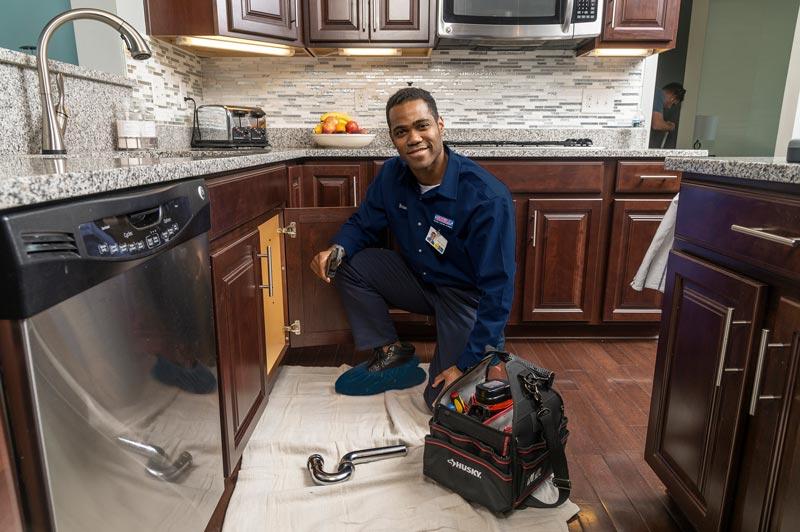You’ve just noticed water dropping from the seal around your sink drain. The next thing is to explore ways to make the seal watertight again, preventing water damage around the leak site. In that scenario, plumber’s putty and silicone are your best bet for fixing the damage.
These two sealing compounds are the main options for plumbers and DIY enthusiasts looking to fix everyday plumbing problems. Both of them are great at their jobs. However, they have a few key differences setting them apart.
This blog post will wade into the plumber’s putty vs. silicone debate to help you decide which to use.
Advantages of Using Plumbers Putty
Plumber’s putty is a pliable, clay-like substance plumbers use to create a tight seal around drains and faucets. It’s highly malleable, so it’s easy to work it into the target area during plumbing fixes.
Plumber’s putty also has high levels of water resistance. Thus, plumbers use it to keep sinks and drains from leaking from the sides. You can also use plumber’s putty across various surfaces ranging from metal to granite. The material won’t stain or discolor the surfaces of your plumbing fixtures.
The putty won’t dry immediately after you apply it, but you can start using the plumbing fixture almost instantly.
Advantages of Utilizing Silicone Putty
One thing you’ll notice in the plumber’s putty vs. silicone debate is how you can use them interchangeably in many cases. Plumbers use silicone as a sealant because it creates a water and airtight seal around plumbing fixtures, reducing the probability of leaks.
Silicone is resistant to high temperatures. Thus, it’s the perfect choice when you’re looking to create a seal on fixtures or parts of your plumbing system that will get exposed to heat. You won’t have to worry about the seal melting.
The material is also resistant to mold and mildew, so you can use it in damp and humid areas without worrying that it might become an unsightly mess. However, keep in mind that silicone is not as flexible as plumber’s putty. So, it might not be the best option for your space.
What Can You Use Plumber’s and Silicone Putty for in a Home?
You can use silicone or plumber’s putty during bathroom sink installation projects or when installing drains, sink strainers, showers, and any other plumbing components that require a watertight seal underneath. They will both help you achieve the same result.
The only difference is that silicone is a modern plumber’s putty alternative. You’re also likely to find silicone putty on store shelves. However, you must pay attention to how you use silicone in plumbing applications. The material is difficult to work with, so it’s easy to leave stains around the fixture you’re working on. You must also ensure the silicone has dried out before using the fixture.

When Not To Use Plumber’s Putty
Plumber’s putty is versatile, but it’s not without its limits. You should avoid using plumber’s putty on ABS or Acrylic because it may affect the material’s integrity and cause fixture damage. Secondly, you should never use plumber’s putty where you need an adhesive.
Additionally, plumber’s putty can’t serve as the seal for a leaky toilet or hold a toilet bowl to a finished floor. The material can’t hold up a toilet’s weight, and the constant contact with urine and toilet cleaners will weaken it.
It’s also generally better to avoid using plumber’s putty on surfaces constantly underwater. So, it’s not the best choice for any fixes in your bathtub. You should use silicone instead of plumber’s putty in that scenario.
How To Use Plumbers Putty
Before using plumber’s putty, you must confirm it’s the best option. Should you use plumber’s putty or silicone caulk? The latter is generally more versatile (although it’s harder to use), so you should first confirm you’ve got the right material for the job. Next, follow the steps on using plumber’s putty below:
- Clean the material and surrounding. You have to clean the part of the material that will be in contact with the putty and the surrounding surface properly to ensure a good seal.
- Take out the right size of putty you need. Close the container to avoid contaminating the remaining putty.
- Knead the putty. You have to roll it around in your hands to make it soft and pliable, then roll it some more into a rope shape.
- Place the putty on the material. Line the putty rope on the underside of the material you’d like to attach, ensuring it forms a complete circle around it. If it’s not enough, re-knead the putty to make it longer (add more if necessary).
- Install the material. Put the shower drain, basket strainer, or other such components you’re working on in the right position. Press down to ensure the fitting is tight.
- Clean excess putty. Use a putty knife to remove excess putty from the sides of the surface, and the surface is ready for use.

Water Leak Repair and Emergency Plumbing Services
Are you still unsure where to tilt in the plumber’s putty vs. silicone debate? Do you need professional help with a water leak? Reach out to the Snell Heating & Air Conditioning team for fast and convenient plumbing services. Our expert emergency plumbers can arrive on short notice to fix your water leaks and save you the hassle of deciding what sealant to use.
Call your friendly plumbers in Sterling, VA, today at (703) 543-9649 to take advantage of our emergency water leak repair services.

